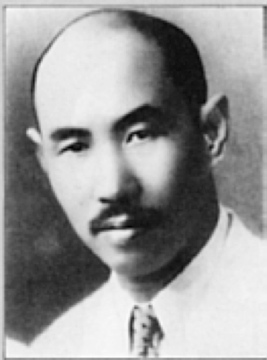“Master of Stillness and Silence” Please share with a friend

Wang Xiangzhai 1885 – 1963
“Master of Stillness and Silence”

Wang Xiangzhai was born in Hebei province, China. As he was a very weak child, his parents sent him to the famous Xingyiquan master Guo Yunshen to improve his health.
 The Wang family had always
had connections with the Guo family. Master Guo Yunshen taught him zhanzhuang gong (post standing postures) that
required the young Xiangzhai to keep
standing for hours.
The Wang family had always
had connections with the Guo family. Master Guo Yunshen taught him zhanzhuang gong (post standing postures) that
required the young Xiangzhai to keep
standing for hours.
In the 1920’s Wang concluded that Xing yi quan had too many individual and two-person sets, and lacked combat value. He took Xingyiquan, and the best of other styles he was exposed to, and organized a set of training procedures, utilizing the shortest time needed to effectively stimulate and ‘crystallize’ an individual’s natural reaction and fighting potential. It was designed to be completed in three to four years of diligent daily training. He renamed the style Yiquan (its original name) to distinguish it from the highly popular Xing yi quan.
 During his young adult
life, Wang Xiangzhai became a soldier in Beijing. At the age of 33, he
traveled throughout China, studying
martial arts with many famous masters including monk Heng Lin, Xing yi quan
master Xie Tiefu,
southern white crane style masters Fang Yizhuang and
Jin Shaofeng, Liuhebafa master Wu Yi Hui, and others. Learning from his
experience, and honoring the truly skilled, Wang stated in public in 1928: “I
have traveled across the country in research, engaging over a thousand people
in martial combat. There have been only 2.5 people I could not defeat: Hunan's Xie Tie Fu, Fujian's Fang Yi Zhuang
and Shanghai's Wu Yi Hui.” A gracious
Fang credited Wang for his clean points adding that his own victory was due to
good fortune.
During his young adult
life, Wang Xiangzhai became a soldier in Beijing. At the age of 33, he
traveled throughout China, studying
martial arts with many famous masters including monk Heng Lin, Xing yi quan
master Xie Tiefu,
southern white crane style masters Fang Yizhuang and
Jin Shaofeng, Liuhebafa master Wu Yi Hui, and others. Learning from his
experience, and honoring the truly skilled, Wang stated in public in 1928: “I
have traveled across the country in research, engaging over a thousand people
in martial combat. There have been only 2.5 people I could not defeat: Hunan's Xie Tie Fu, Fujian's Fang Yi Zhuang
and Shanghai's Wu Yi Hui.” A gracious
Fang credited Wang for his clean points adding that his own victory was due to
good fortune.
After 7 years of research and study, Wang established himself when he penetrated the circle of famous masters in Beijing, Tianjin and Shanghai. He reunited with friend and classmate, the respected Liuhebafa Chuan master Wu Yi Hui, and became friends with Baguazhang master Zhang Zhaodong. Wang was one of the first Chinese teachers to publicly teach the practice of Zhan Zhuang, ‘standing like a tree’.
In the 1940s, a disciple, journalist Zhang Bi, publicly called the Yiquan style Da Cheng Chuan, which means "great achievement or grand boxing". It is still known by both names. Later, Wang would tell his students “there is no such thing as grand achievement in martial arts; work and strive to improve everyday because there is no limit to learning”, a theme stressed by many of today’s martial artists.
Wang was visited by many Japanese experts during WW 2. One, Kenichi Sawai, assumed to be his student, created a school in Japan calling his style Taikiken. Sawaii was however solely instructed by Wang's successor Yao Zongxun. Yet another person who became famous in the martial arts Richard Kim studied with Wang in Shanghai during WW2. At the end of his life, Wang worked with different hospitals in research into the healing aspect of Zhan Zhuan.
 Wang’s legacy lies in his
counsel, internalized through his teachings, his students, and the prevailing
influence of his Master Guo Yunsheng.
Wang’s legacy lies in his
counsel, internalized through his teachings, his students, and the prevailing
influence of his Master Guo Yunsheng.
“In silence there must be movement,
and in motion, there must be silence.
A small movement is better than a big,
no movement is better than a small.
Silence is all the movements’ mother.
In movement you should be like a dragon or a tiger,
In non Movement you should be like a Buddha.”
-- Wang Xiangzhai
